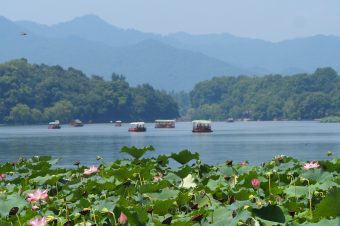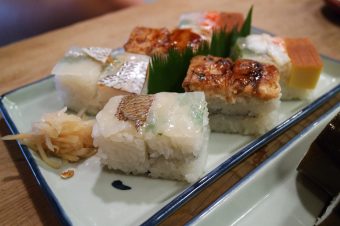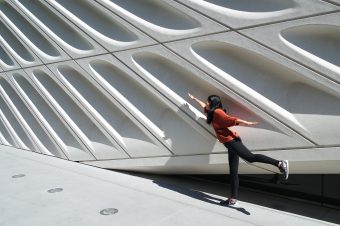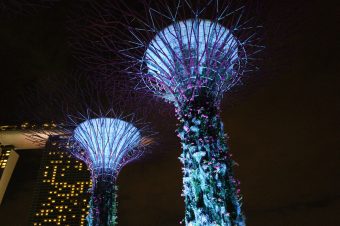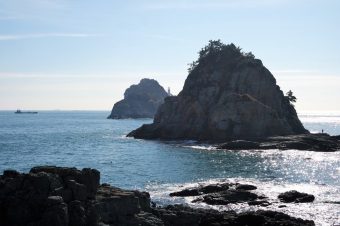If you only have a limited amount of time to explore the bustling capital city of Japan, there are still a lot of things you can do! Here is how I made the most of my Tokyo exploration in 24 hours. This short stop in Tokyo was part of my 8 days trip traveling from Tokyo to Hokkaido.
Pre-departure
Airports
Tokyo has two international airports: Narita International Airport and Haneda Airport. Find out which one is most convenient to get to from your place of departure and which one is more affordable for you to fly into.
JR Pass
Get your JR Pass (for more detailed directions, click on our guide) before leaving if you are planning to hop around Japan after going to Tokyo.
Arrival
Given my track record with delayed planes, we had a surprisingly smooth flight from SFO → LAX → Tokyo Haneda Airport.
We arrived bright and early in Tokyo Haneda Airport at 5am but unfortunately the JR office doesn’t open until 7:45am! So with 2+ hours to kill, we decided to walk around the airport.
By the time we circled back to the JR office in the airport at 7:30am, a line has already started forming. But we were able to get our passes relatively quickly.
On the way to to our first destination, we stopped by the Hamamatsucho Station to reserve our JR train tickets for the rest of our trip. We were lucky enough to get seats on the much coveted overnight train from Aomori to Sapporo (omg!!).
Note: you can only get the tickets at a “JR Ticket Office” not a “JR Travel Service Center”
Here is a list of major JR offices in Japan:
http://www.japanrailpass.net/en/exchange.html
Here is a list of stations around Tokyo that you can reserve your train tickets at:
https://www.eki-net.com/pc/jreast-shinkansen-reservation/English/wb/common/ticketwindow/index.html
Tsukiji Fish Market! (築地市場, Tsukiji Shijō)
Tsukiji Market is best known for being one of the world’s largest fish markets. Their tuna auction is an especially popular attraction for visitors but only 120 people get to enter the auction each day. People usually have to start lining up long before 5am if they want to have a chance to see the auction.
Of course, we didn’t make it early enough for the auction, but we had fun regardless wandering around the different stands and the outer market.
Directions: Take the Oedo Subway Line to Tsukiji Shijo Station. Alternatively, it can be reached in a five minute walk from Tsukiji Station on the Hibiya Subway Line. The closest JR station is Shimbashi, from where you can walk to the market in about 15 minutes.
Shibuya Crossing
After the fish market, we headed off to the Shinjuku station to drop off our heavy backpacks (finally!) in the coin lockers (コインロッカー → literally read as “koin rokkā”).
At Shibuya, we got to witness the amazing Shibuya Crossing. It’s really quite a sight, as every corner of the intersection starts filling up with more and more people, waiting for the pedestrian light; then right as the light turns, the crowd begins pouring into the streets to cross, all at once, like a dam that has been broken.
Ghibli Museum
Our main attraction for the afternoon was the Ghibli museum. Because it’s so popular, we weren’t able to get tickets from the JTB office (only 200 tickets are released per admission day for all overseas sales), so we ended up having to buy them from one of the local Lawson convenience stores in Japan.
We weren’t allowed to take pictures once inside the museum, but it consisted of 3 stories, with the Ghibli Gift Shop all the way at the top (the crowd here was huge!). We were also given the special privilege to watch a never-before-released Miyazaki short film! I couldn’t really understand it since everything was in Japanese and there were no subtitles, but it seemed to be about how the planets and the universe were created (from planting planetary seeds).
Edit 4.18.2017: I found more info on the film!
Hoshi o Katta Hi (星をかった日, literally “The Day [I] Raised (Harvested) a Planet”) is an animated 2006 short film produced by Studio Ghibli for their exclusive use in the Saturn Theater at the Ghibli Museum in Mitaka, Tokyo, Japan. The film is based on a story by Naohisa Inoue.
The short film is about a boy who lives and works on a farm. One day when going to sell vegetables at a market, his cart breaks down. Two strangers, a frog and a mole, offer him a strange seed in exchange for the vegetables. The boy accepts and finds that the seed grows into a miniature planet. It continues growing as he tends to it, forming an atmosphere, weather systems and life. After being taken back to the city, he meets the stranger who sold the seed to him, and they release the planet into a galaxy of similar planets, where it will grow for years until becoming a real planet.
Directions: Go to the Mitaka station on the JR East line (about 20-30 minutes from Shinjuku station, depending on whether you get an Express or Local train), exit from the South or Minami entrance (南口), and follow the signs for the Ghibli Museum.
Asakusa (浅草)
We hit Asakusa (浅草) before dinner and walked around the area. There were a lot of small food and gift shops that lined the main street as we made our way down to the famous Sensō-ji, a Buddhist temple dedicated to the bodhisattva Kannon. In front of the temple, visitors have a chance to gain divine blessings by taking in the smoke emitting from the big incense burner in the middle. Those who wish to try their luck can also pay 100 yen to have their O-mikuji (おみくじ) paper fortune told. Supposedly, if you get a good fortune, you should keep it with you, but some people believe that if you tie it to the wall of metal wires, it will somehow multiply the amount good luck that the person will get.
If you get a bad fortune, however, you can dispose of it by folding the fortune and tying it to the metal wires.
I did some research and came across this fun fact:
“A long time ago, they didn’t have convenient walls of metal wires, so people used to tie the fortunes on nearby pine trees. It is a bad pun on the name for pine tree 松(まつ) “matsu” and the verb ‘to wait’待つ (まつ) also “matsu.” The thought was that the bad luck would “matsu” or wait by the “matsu” pine tree instead of following you home”
Directions: From Tokyo Station, take the JR Yamanote Line to Kanda Station and transfer to the Ginza Subway Line for Asakusa. If you are going from Shinjuku Station, take the orange JR Chuo Line to Kanda Station and transfer to the Ginza Subway Line for Asakusa.
Akihabara (秋葉原)
After dinner, we headed over to Akihabara (秋葉原). This is Tokyo’s anime, manga, and electronics district. As we walked along the streets, we also saw a lot girls dressed up in maid outfits who tried to get us to go to their maid cafes. Contrary to popular belief, maid cafes are actually not strictly reserved for men – they are also enjoyed by women and families as well (but some of the maids did look really young).
Directions: Akihabara Station is served by the JR Yamanote Line, JR Keihin-Tohoku Line, JR Sobu Line, the Tsukuba Express and the Hibiya Subway Line. Suehirocho Station on the Ginza Subway Line is located around the northern end of the district.
Shinjuku Station
As the coin locker service closes at 10pm, we made our way back to Shinjuku Station at 9pm. Little did we know that we would end up needing that whole hour of buffer…the reason being, no one warned us how BIG (and with so many floors??) the station actually is! Walking around that huge and confusing station made me feel like a freshman in Berkeley again trying to navigate the maze that is Dwinelle Hall.
A remote recollection of a sign with the words “Lumine 2″ and a flower shop were the only clues I had of where our lockers could possibly be. After attempting to use Google maps without success, scouring through at least 4 station maps, and asking 3 station personnel for directions, we finally made it to our lockers at 9:50pm.
Needless to say, this station will forever remain in my memory as one of the most prominent and traumatizing place for me in Tokyo
Pro tip: don’t store your stuff here unless you enjoy getting lost and going through a roller coaster of emotions on whether or not you will ever find your stuff/get out of the station with your legs intact >__<
Edit 10/5/2017: Looks like East Japan Railways have launched a free English/Japanese app to help people get around the station! Wooo this is so exciting!! Read more about it here.
This station has now became so ingrained in my memory that I was able to tell my coworker with -100% hesitation which station Tokyo’s red light district is in (where we will be going next) when she asked about interesting places to visit.
Looks like I’m not the only one that feels this way about Shinjuku Station.
Kabukichō (歌舞伎町)
Coincidentally, our accommodation for the night was near Tokyo’s red light district. So after dropping off our heavy backpacks, that’s where we headed to continue on with our Tokyo night adventures!
According to Wikipedia,
Kabukichō (歌舞伎町) is an entertainment and red-light district in Shinjuku, Tokyo, Japan. Kabukichō is the location of many host and hostess clubs, love hotels, shops, restaurants, and nightclubs, and is often called the “Sleepless Town” (眠らない街). The district’s name comes from late-1940s plans to build a kabuki theater: although the theater was never built, the name stuck.
Not surprisingly, suspicious activities can’t really be seen by the general public when strolling along Kabukichō. At best you see a few pimps loitering around and some questionable shops/stores dotting here or there. Otherwise, it just felt like a normal pedestrian district in Asia.
Directions: get to Shinjuku Station and walk for about 10 minutes
Before heading back to our hotel, we stopped by a convenience store to buy onigiris and a few Asahi beers.
I LOVE ASIA’S CONVENIENCE STORES!! (here is a list of some of the different ones that we went to in Japan):
- Seven-Eleven
- Lawson
- FamilyMart
- Circle K Sunkus
Accommodations
There are a number of different types of accommodations you can find in Japan, including ryokans, onsens, airbnb, hotels, etc.). We decided to try out a capsule hotel in Tokyo. The location of this capsule hotel was perfect as it was right next to Kabukichō, so it was convenient to go back to rest after we were done with exploring the area.
I didn’t really have any expectations for the capsule hotel, but was pleasantly surprised by how cleaned everything was. The floors are separated by genders. When capsule hotels were first built they catered mostly to the male businessmen who were looking for a quick, cheap and convenient stay whenever they needed to travel for business so a lot of the capsule hotels originally didn’t even host females. This particular capsule hotel we stayed in also had a large bathhouse for men only and a mixed-gender lounge floor that everyone can hang out in. On each of the capsule room floors there are communal bathrooms for guests to take showers in and gym lockers to store your thing in (since the capsules are so small you can’t put all your belongings in there). In each capsule, there is a small TV, a pillow and a blanket. All in all, it was a fun experience. If you’re looking for a relaxing night stay it might not be for you, but it’s definitely worth trying if you’re just looking to try something new.
















































